|
|
 |
| My Favourite Planet > Blogs > Cheshire Cat Blog > 2011 |
 |
 |
back |
The Cheshire Cat Blog
 |
 |
December 2011 |
 |
| |
 |
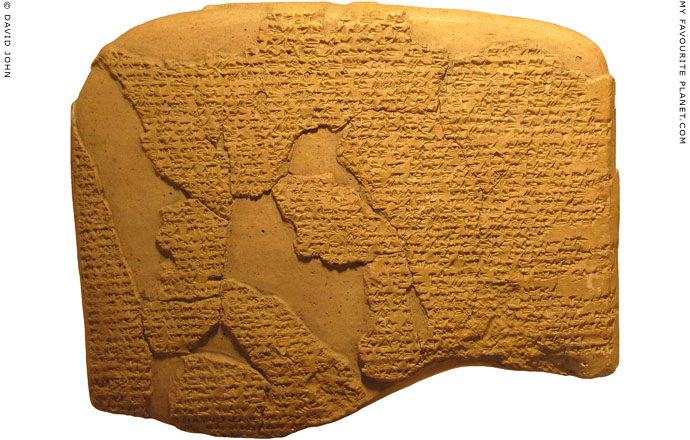
The "Kadesh Treaty", the earliest known parity peace treaty, circa 1259 BC. |
| |
Peace on Earth,
good will to all Hittites
This month, the briefest Cheshire Cat Blog ever. Short and sweet. And no footnotes. |
| |
| |
Around 3270 years ago the Hittite king Hatusili III and Egyptian pharaoh Rameses II decided to give peace a chance and signed an "eternal treaty" of "peace and brotherhood for all time". As far as we know, the Hittites and Egyptians have never gone to war with each other since. A good result, then.
The Hittites were at the time a growing imperial power in the Middle East. From their central Anatolian capital Hattuša (today Boğazkale, Çorum Province, Turkey), they expanded westwards to the Aegean Sea, eastwards to northern Mesopotamia (today Iraq), beyond which the Assyrian kings ruled, and southwards to the edge of Egyptian territory at Kadesh (or Qadesh, "the Holy City"), north of Amurru, the Biblical Canaan (today part of Syria), on the Orontes River.
Hittite threats to Egypt's northern border led to the four-day battle Battle of Kadesh in 1274 BC, between Rameses II and Muwatalli II, predecessor and brother of Hatusili who was a commander at the battle. It was the earliest known battle for which recorded tactical details have survived, and is also thought to have been the largest chariot battle in history, with as many as 6,000 chariots taking part. Casualties were very high, the result was indecisive, and Rameses himself is said to have narrowly escaped with his life.
Following further border skirmishes, ambassadors of the two powers met, and, 15 years after the Battle of Kadesh, the peace treaty was concluded and copies inscribed on silver tablets were exchanged between the rulers. In the treaty of 18 articles, both sides not only pledged peace and friendship but also assistance against other enemies - a sort of early third party insurance policy. |
|
|
| |
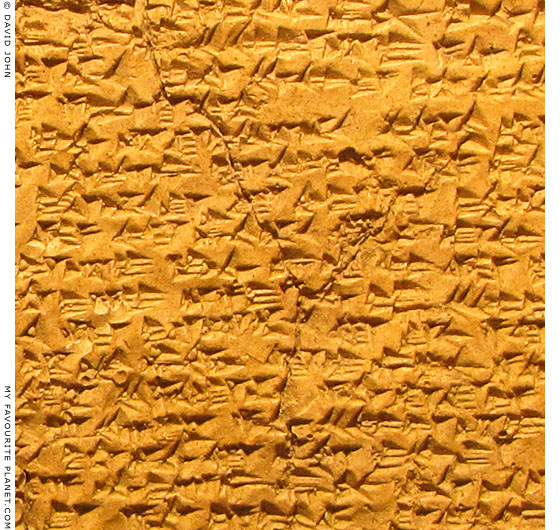
Detail of the cuneiform script on the "Kadesh Treaty".
The photo at the top of the page is not much smaller than lifesize.
But even magnified, it is obvious that the tightly-spaced lines of
miniscule script, made by pressing a fine, wedge-shaped stylus into
damp clay, is not only difficult to read, but must have been a real
headache-inducing chore for modern scholars to decipher.
Museum of the Ancient Orient (Eski Şark Eserli Müzesi),
Istanbul Archaeological Museums. |
| |
The original silver tablets have so far not been discovered by archaeologists and are thought to have been lost forever. Fortunately, copies of the treaty were made by both parties. The Egyptian copy was written in hieroglyphics at the Temple of Amun at Karnak. The French philologist Jean-François Champollion (1790-1832), who deciphered the Rosetta Stone in 1822, was the first to discover the Egyptian versions in 1828. At this time the historical Hittites, known from brief references in the Old Testament, had yet to be rediscovered, and the identity of the "Great King of Khatti" referred to by the Egyptian text was to remain a mystery for over 70 years. The Hittite version, written in the cuneiform script of the Near Eastern diplomatic language - or lingua franca - Akkadian (see Big Money, The Cheshire Cat Blog, May 2011), was transcribed onto clay tablets, three of which were discovered by the German Hugo Winckler (1863-1913) and Turkish Theodor Makridi Bey (Θεόδωρος Μακρίδης, 1872-1940, later to become the second director of the Istanbul Archaeological Museum) during their excavation of Hattuša in 1906.
Two of the tablets, including the one in the photos above, are now in the Museum of the Ancient Orient, Istanbul. There seems to have been no direct connection between Kadesh and the treaty itself, and many historians prefer to call it the Egyptian-Hittite Peace Treaty or the Ramses–Hattusili Treaty, some even like to refer to the "pax Hethitica-Egyptiaca". The museum's exhibit label dates the treaty to 1269 BC, though many scholars now agree on a date ten years later. As ever, all such dates remain matters of scholarly contention.
A third copy is said to be in Berlin, presumably in the Museum of the Ancient Near East (Vorderasiatisches Museum) of the Pergamon Museum. If it is, the museum seems to be keeping very quiet about it. We hope to add more information about this in the near future.
In 1970 a replica of the treaty, made by Sadi Calik, a sculptor and lecturer at the Istanbul College of Fine Arts, was presented by the Turkish Minister of Foreign Affairs, Ihsan Sabri Caglayangil to the United Nations Secretary-General U Thant, as a gift from the government and people of Turkey to the UN. It now hangs outside the entrance to the chamber of the Security Council in New York.
During an address on receiving the "Alliance of Civilizations Report" in Istanbul, on 13 November 2006, the then United Nations Secretary-General, Kofi Annan said:
"Let us take our inspiration from an inscription that can be seen not far from here, in the Istanbul Archaeological Museum – and which, thanks to the generosity of the Turkish people, can also be seen in replica at UN Headquarters in New York, outside the Security Council chamber. It records the peace treaty concluded between the Hittite and Egyptian empires, after the bloody battle of Kadesh in 1279 BC. Ending decades of mistrust and warfare, this treaty was a milestone of its era. It reached far beyond mere cessation of hostilities, committing both sides to mutual assistance and cooperation. It was, in fact, the literal embodiment of an alliance between two great civilizations.
Today, as we meet to make our own commitments, and to share our vision of a peaceful future, I hope we can all be inspired by this ancient pact to build our own Alliance between civilizations, cultures, faiths and communities." |
| |
Hittite heroes
Put your mouse
over an image to see further details. |
| |
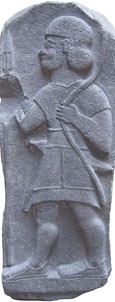
Hittite warrior |
| |

Hittite Hendrix |
| |
|
| |
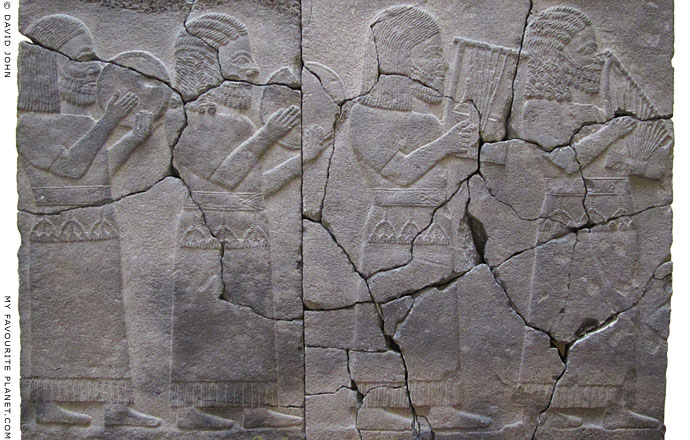
Something to celebrate.
Late Hittite basalt relief depicting musicians, 8th century BC.
From Samal (Zincirli), southeastern Turkey.
If this band turned up to celebrate the peace treaty, they were about 500 years late.
Maybe their van broke down on the way. Never mind, guys, it's the thought that counts.
Museum of the Ancient Orient (Eski Şark Eserli Müzesi), Istanbul Archaeological Museums. |
| |
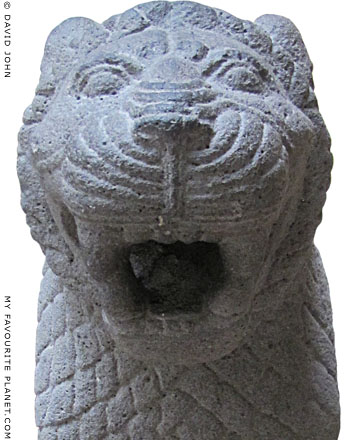
Late Hittite basalt portal lion sculpture.
From Maraş, 9th century BC.
Museum of the Ancient Orient,
Istanbul Archaeological Museums. |
Well, that's it for this year.
The Cheshire Cat and his pals
wish you all
Merry Christmas
(or Happy Holidays, if you prefer)
and
a Peaceful New Year
See you again in 2012.
|
|
Article and photos copyright © David John 2010-2011
The Cheshire Cat Blog at My Favourite Planet Blogs
We welcome considerate responses to these articles
and all other content on My Favourite Planet.
Please get in contact.
The photos on this page are copyright protected.
Please do not use them without permission.
If you wish to use any of the photos for your website,
blog, project or publication, please get in contact.
Higher resolution versions are available on request. |
 |
Visit the My Favourite Planet Group on Facebook.
Join the group, write a message or comment,
post photos and videos, start a discussion... |
|
Views of blog authors do not necessarily reflect those of the publishers
or anyone else at, on or in the vicinity of My Favourite Planet. |
 |
| |
|
|
| |
| |
 |
| |
 |
| |
 |
| |
 |
| |
 |
| |
 |
| |
George Alvanos
rooms
in Kavala's historic Panagia District
Anthemiou 35,
Kavala, Greece
kavalarooms.gr |
| |
| |
Olive Garden Restaurant
Kastellorizo,
Greece +30 22460 49 109
kastellorizo.de |
| |
| |
Papoutsis
Travel Agency
Kastellorizo,
Greece +30 22460 49 286
greeklodgings.gr |
| |
| |
|